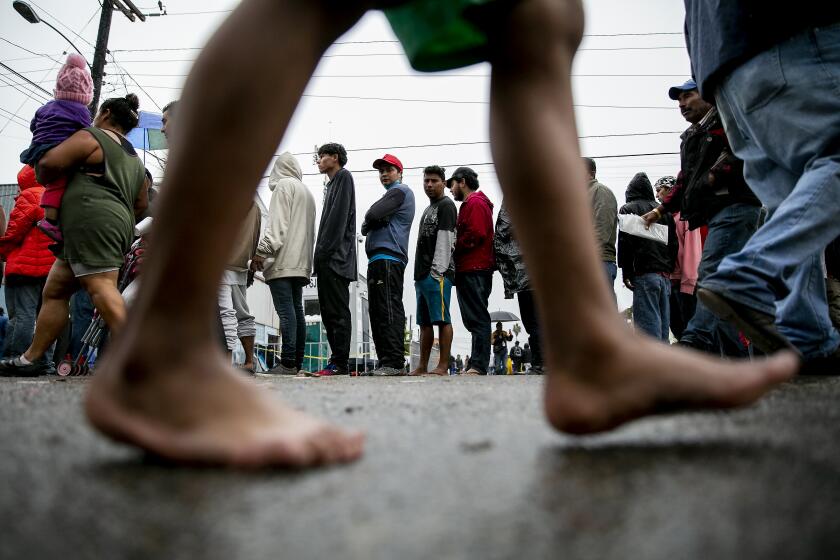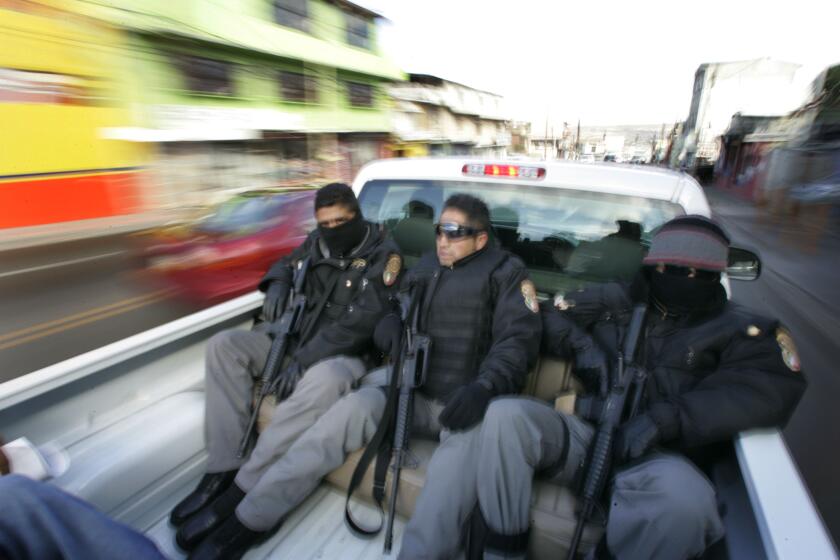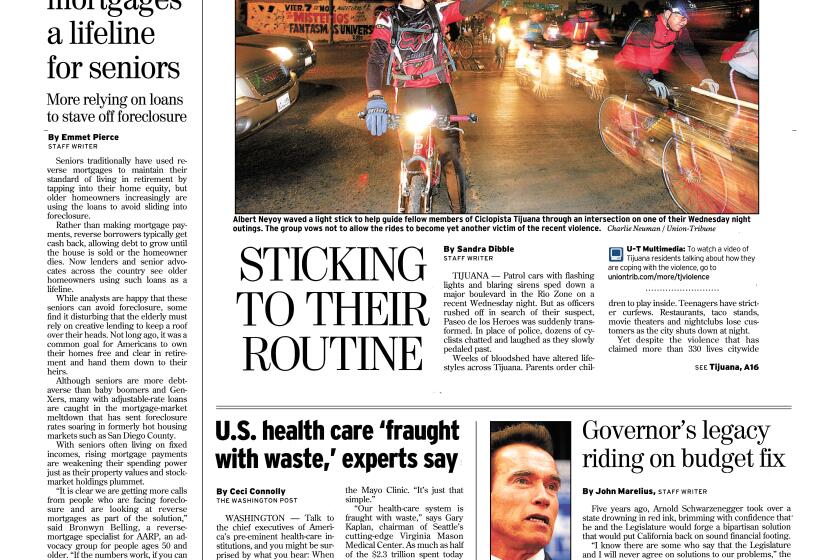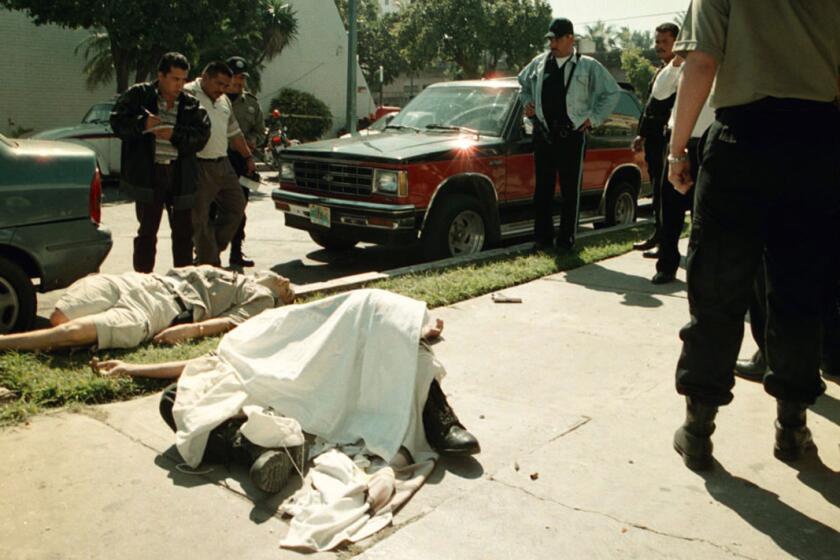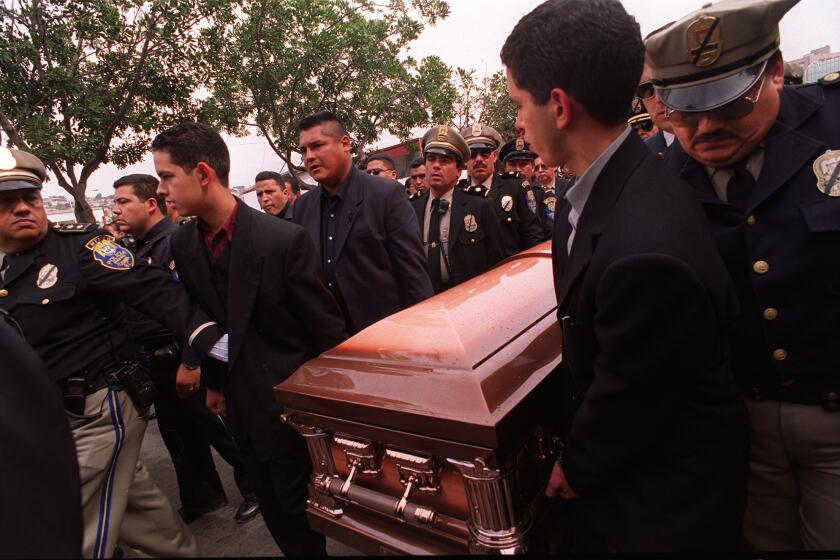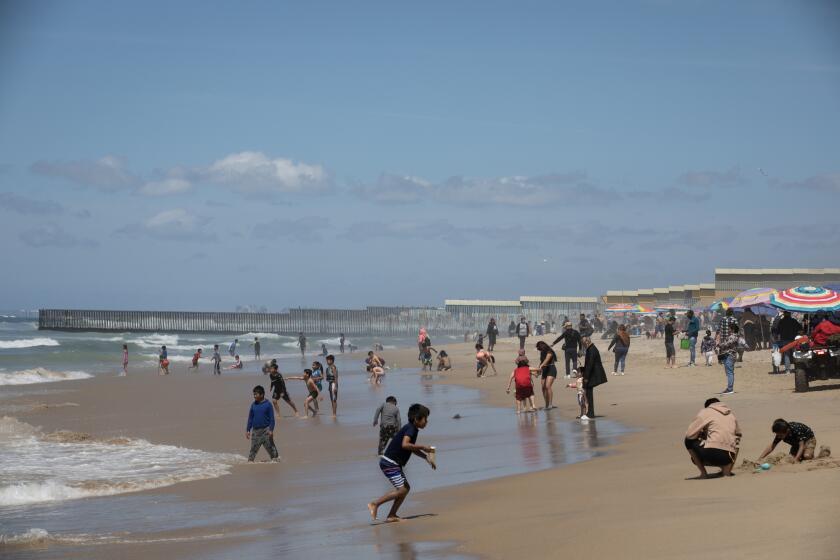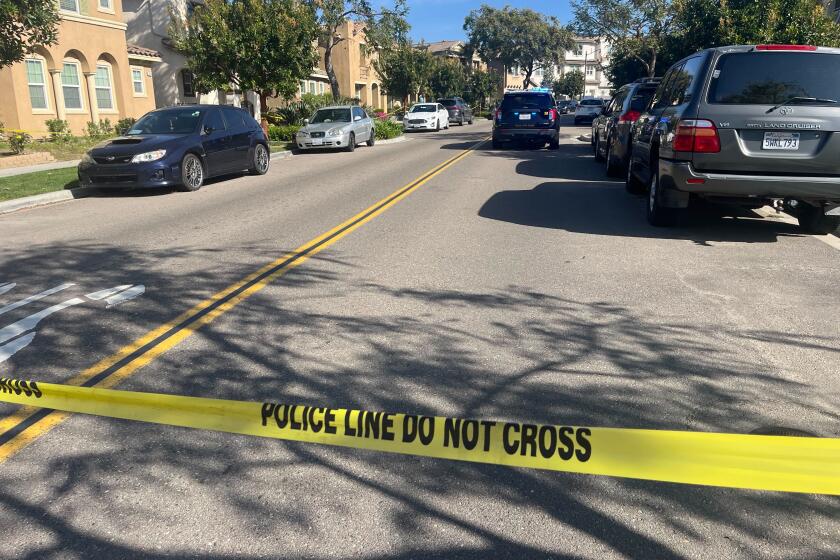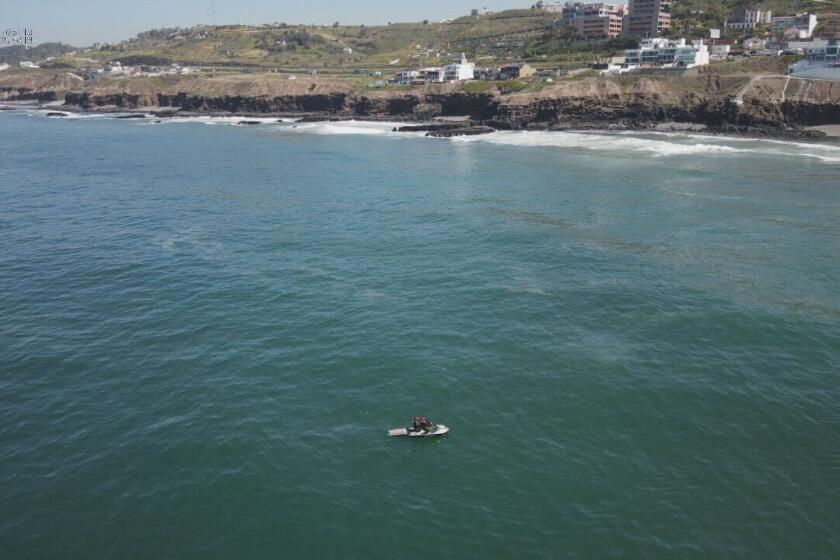Builders target Tijuana’s stagnant areas
Modern loft apartments overlooking Tijuana’s oldest tourist district. Boutique hotel rooms amid curio stores and taco shops. A breezy red brick office building in the place of a dilapidated drug house.
A new wave of developers is bringing a fresh eye to old Tijuana, breathing life into decaying and abandoned buildings, and creating new ones. They talk of a city with art galleries, cafes, breweries, colorful murals, bike stations, collaborative work spaces, markets with organic produce. They envision bustling streets where adventurous foreign tourists mingle with city residents.
A city of more than 1.7 million, Tijuana is in the midst of a generational transition, and the modest flurry of mixed-use projects near the U.S. border is an expression of that. Whether blending in or standing out from their surroundings, the projects aim to revive a section of the city that has stagnated.
Developers hope their projects set a precedent that will encourage other efforts that bring residents and businesses back to Tijuana’s downtown. It is a vision that would be strengthened under the city’s plans to update development rules and launch a new public transportation system.
About a dozen new projects have arisen in Tijuana’s centro historico, the name for the old center of the city made up of 53 blocks near the U.S. border that includes Avenida Revolucion, the city’s traditional tourist strip. This is an area that has been struggling in part because of the drop in U.S. tourism — the result of long waits at the border after the 9/11 terrorist attacks, economic recession and drug-related violence in Tijuana that spiked from 2008 to 2010.
But in fits and starts, abandoned blocks have been coming back to life. Genaro Valladolid, a commercial real estate broker, sees a turnaround that has taken place in phases over several years — from the revival of bars on Sixth Street to the reopening of Caesar’s Restaurant on Avenida Revolucion and the 2014 launching of the Escuela Libre de Arquitectura in the Zona Norte.
“Everything that’s going on in Tijuana, with the food, wine, craft beer, culture, in my view it’s very organic, very grassroots, where young people, or people with a different outlook started doing things,” he said.
More changes are in the works. Near Seventh Street, an independent arts group called Cine Tonala is preparing to turn an abandoned building into a cultural center, offering film, theatre, music performances. At the corner of Fourth Street, businessman David Saul Guakil is turning the old Sara department store into offices with commercial space on the bottom floor, and perhaps a rooftop beer garden.
Architect Jorge Gracia, founder of the Escuela Libre, said Tijuana’s residents needed to change the city’s narrative: “We felt that our history, our souls were taken by this mafia, and after everything calmed down, the good people felt the necessity of expressing in the arts, music, restaurants.”
Developers in Tijuana are paying attention to what their buildings look like. “They’re investing in architecture, which is something that another generation didn’t do,” said Hector Bustamante, whose company, Bustamante Realty Group, works with several of the projects. “It is changing the face of downtown. Now we have other developers looking at their projects, and saying, ‘I want to do something like that.’”
David Mayagoitia, an industrial real estate developer, called the efforts laudable but said “they’re small projects on a piecemeal basis.” He has his own proposal for downtown: the establishment of an IDEA district that would bring design and tech jobs to the city.
“The first thing we need to do is repopulate our downtown, and make it an exciting and vibrant and beautiful place,” said Mayagoitia, who urges government policies that encourage greater density and the use of public transportation.
For years, Tijuana grew outward. As rapid population growth in the 1990s and 2000s created a demand for more housing, the federal government encouraged vast development projects that brought tens of thousands of tiny houses to the city periphery. But Mexico has since dramatically changed course with efforts aimed at encouraging greater density.
Under President Enrique Peña Nieto, “the idea is that we don’t extend our territory, that we become compact and connected,” said Nora Marquez, head of Tijuana’s Municipal Planning Institute, known as IMPLAN.
To that end, city planners have been busy updating the city’s urban development plan to incorporate the new policy — from downtown Tijuana to the city’s Rio Zone to areas to the east. Marquez said the aim is to encourage density along a Bus Rapid Transit route scheduled to open this year.
Tijuana is one of five cities in Mexico working with the nonprofit group Embarq Mexico — part of the WRI Ross Institute for Sustainable Cities — to review its planning rules under the notion of “transit-oriented development.”
“Local governments already know that urban development policies are now for the re-densification of centros historicos,” she said. “They need the instruments to allow it to happen.”
The launching of Tijuana’s Bus Rapid Transit gives the city a unique opportunity for change, said Tanya Jimenez of Embarq Mexico. “It gives us a framework, so that along its path, and its stations, we can create urban development to complement it.”
Private developers are often the first to spur the revitalization of decaying downtowns, Jimenez said. In many cases, the projects are geared to high-end markets, and it is up to the city to create the mechanisms “so that people with fewer resources also have access to these centros historicos.”
Members of the Urban Land Institute of Tijuana and San Diego picked up on the area’s potential in a Revitalization Concept Plan prepared in 2013 that focused on an area three blocks wide and nine blocks long straddling Avenida Revolucion.
The plan recommended re-launching the area for local residents, with parks, offices, shops and higher-density housing. “It gets better every time I go there,” said Greg Shannon, a San Diego development expert who led the panel, with new cafes, restaurants and retail spaces.
“The one that will really have legs is residential,” he said. “If IMPLAN is willing to promote high-density residential, that’s a game-changer,” Shannon said.
The developers have a vision, said Marquez, the planning director. “They have a need to be innovative, of doing this here in the city rather than going elsewhere. And if we give them the right tools, I think a lot is going to get accomplished.”
San Diegan sees promise on Avenida Revolution
San Diego developer Greg Strangman grew up traveling to Baja California. But he stopped around 2008 when battles broke out between drug groups vying for control of the Tijuana plaza. Now he’s back, preparing to launch a boutique hotel on Avenida Revolucion.
With plans to open in mid-summer at the old Hotel Lafayette, he aims to entice travelers willing to spent $75 to $150 per night. He expects to draw a cross-border clientele to the eight-room hotel near the corner of Third Street, doing bookings through Airbnb.
“There’s a lot of Americans that don’t want to spend the night in Tijuana because they don’t know where to go eat, where to go have coffee, where to go shopping for art or clothing, where the architecture is,” said Strangman, 48, who grew up in Del Mar. “For sure, they don’t know where to stay.”
In San Diego, Strangman has worked in different areas, including Bankers Hill, East Village and Point Loma, where he operates The Pearl Hotel. “The only type of projects that I do is breathing new life into buildings,” said Strangman, who calls himself a “re-developer.”
After years of staying away from Tijuana, Strangman returned in 2013 to participate in a technical advisory panel for the Urban Land Institute’s district council for San Diego and Tijuana that was looking at ways to revitalize the Avenida Revolucion district.
“It just so happened to be at a time when I told my wife that I needed to do another project somewhere, just to be able to prove to myself that we can do something outside San Diego.”
“We looked at Los Angeles and New York,” he said. “But then I thought, ‘Why not Tijuana?’ We liked it here.”
Among Strangman’s San Diego projects is One Bunk Barrio, a studio next to his Barrio Logan office that he rents out through Airbnb. He plans to extend the One Bunk brand to the Hotel Lafayette, as well as to a future hotel in the Guadalupe Valley.
For both projects, Strangman is collaborating with Tijuana architect Jorge Gracia, whose Escuela Libre de Arquitectura is just down the street. “We need aggressive people doing investments in this area, to prove that densifying the city is the way to go, that you don’t really need a car to move,” Gracia said.
While arts initiatives have helped revive the downtown area from its darkest days, for long-term changes, “you need to focus the business and the art together,” Gracia said.
Near the corner of Third Street, the Hotel Lafayette has been around for six decades as a small, family-run establishment catering to a middle-class clientele, said Jaime Brambila, the property’s 85-year-old owner.
Strangman’s willingness to invest on Avenida Revolucion is encouraging to longtime merchants and property owners who have never given up hope. “You can see a lot of tourists coming back, but there’s not as much as there used to be,” Brambila said. “This is a completely new phase.”
Strangman signed a 15-year master lease on the building, with three five-year renewal options. “Buying the property would have meant more capital outlay,” Strangman said. “This way I can put more of my capital into renewing the building.”
Doing business in Tijuana is “a little bit different” than in San Diego, he said. He’s learning how taxes work in Mexico, and how to hire and fire workers.
The hotel is between Third and Fourth Streets, above La Justina Restaurant and a curio shop. To reach the rooms and the hotel’s small lounge bar, guests will climb a stairway leading from the sidewalk to the hotel. “It’s going to be a very experimental, adventurous person that’s staying with us,” Strangman said.
“I really feel like our building is going to help make a change for that neighborhood, “ Strangman said. “It’s going to encourage people to visit this city.”
Sleek offices target young people
For years, Fernanda Padilla has developed gas stations in different parts of Tijuana. But she yearned for something more: a project that would make a difference in the city’s decaying downtown, one that would bring young and creative people back to the center of the city.
The result is Brik10, her three-story red brick office building that opened in December on 10th Street between Madero and Negrete avenues. With 17 offices — all now rented — it has a rooftop garden terrace, meeting space, a cafe on the ground floor and off-street parking. Its tenants include architects, furniture designers, a specialist in high-end restaurant interiors and social media marketing strategists.
Padilla wanted a space for a new generation of Tijuanenses while keeping the spirit of downtown Tijuana’s origins. “It’s the most important part of the city, where commerce, the city’s livelihood started,” she said,
When Padilla bought the property, 65 feet wide and 200 feet deep, it was occupied by small shops and abandoned houses taken over by vandals and drug addicts. Her vision for the project was inspired, she said, by seeing how things are done in other places.
“My turning point was seeing cities like Mexico City, like New York,” said Padilla. “Tijuana is so vibrant, why not just make it better?”
Padilla hired a Tijuana architect, Raul Jimenez Susarrey. They aimed for an old-fashioned feel, something different from the glassy office buildings that dominate Tijuana’s main business district, the Rio Zone.
Brik10’s concept “is a bit more artistic, more nostalgic,” Jimenez said. “It calls out to new generations, urges them to not abandon downtown.”
Padilla, born in San Diego, grew up on both sides of the border. She graduated from Our Lady of Peace in North Park, and earned a law degree at the Universidad de Valle de Mexico in Mexico City. She’s worked in politics in Tijuana, but also in Washington where she served on the Capitol Hill staff of a Texas congressman.
Now 43, she owns gas stations in Tijuana, and has relocated her own business offices to Brik10. Also in the building is her father, Praxedis Padilla, a former judge and politician with the Institutional Revolutionary Party.
“Our generation paid more attention to personal interests,” said Praxedis Padilla, who for many years was a developer. “We had neither the vision nor the generosity to sacrifice some of that interest in order to improve the city. The newer generations are changing the city with a completely different vision, risking their capital, and risking their prestige. I think this is a great generational change for Tijuana.”
Padilla said she did not lack for prospective tenants — just not the ones she wanted. “We had Chinese restaurants, hair salons that wanted to rent here,” she said. “It’s not the fit. I preferred to wait, that it be a little family. It’s more a working space for creative people.”
Among the tenants are Bolt Media, a marketing firm with a staff of 14 working out of Brik10, and Manuel Martinez, an architect who has designed the interiors of several high-end Tijuana restaurants. Martinez said he likes the building’s look, but it was the parking space that was key to persuading him to switch from the Rio Zone. It didn’t hurt that the rent was 15 to 20 percent less expensive.
“The idea was that not only the building would change but also the renters. That was our concept,” Jimenez said.
Padilla and Jimenez are now preparing to launch a second project: building a rental apartment building in a nearby well-to-do residential neighborhood, Colonia Cacho.
For now, Padilla said, “we’re just finishing this, and taking a deep breath, showing the bank that everything is on time.”
A revival downtown
Sergio Rosas Bustamante recalls visiting one of his grandfather’s properties in downtown Tijuana when he was still a little boy. “I remember him telling me, ‘I have no idea what to do with this.’”
Five years after Alfonso Bustamante Labastida died, the grandson has figured out the answer: Build a 20-unit residential building with lofts and one-bedroom apartments whose balconies overlook Avenida Revolucion. Provide parking and security, and charge about $800 a month.
The chief executive and co-owner of Grupo Inmobiliario Bustamante, Rosas, 41, is pioneering rental housing in downtown Tijuana. His idea is to open possibilities for young professionals, retirees and others — either singles or couples — eager for the excitement and convenience of living in the center of town.
“My grandfather always said, ‘What you earn in Tijuana, you invest in Tijuana,’” Rosas remembered, seated behind his desk overlooking Tijuana’s Campestre golf course.
Though born in Tijuana, Rosas grew up on both sides of the border, attending boarding school in Canada, then graduating from St. Augustine High School in North Park before getting a degree from CETYS University in Tijuana. A member of one of Tijuana’s most prominent families, Rosas said, “I consider myself a San Diegan as well.”
In pursuing his downtown Tijuana projects, Rosas has found inspiration in the transformation of downtown San Diego.
“I remember going there as a little kid, to the Spaghetti Factory, and being afraid,” he said. “Now I love going to downtown. It’s amazing what’s been done over there, and my thinking is why can it not be done here as well?”
Rosas’ first downtown Tijuana project, Septima y Constitucion, opened in September 2013. It involved the conversion of a pair of rundown family properties on Avenida Constitucion, a street lined with shops that runs parallel to Avenida Revolucion.
Rosas hired Tijuana architect Ramon Guillot to convert the upstairs into 12 lofts while keeping the bottom floor as retail space. Unsure whether he could find tenants, Rosas kept the rents low, initially charging $450 to $550 a month — and the units were snapped up even before the project was completed.
“We thought people would be hesitant to live downtown, given that there was kind of a stigma as there was in downtown San Diego, pre-Horton Plaza,” Rosas said. But he has been pleasantly surprised: “It’s exceeded our expectations, to the point where we had enough faith to do a new building on Avenida Revolucion.”
Guillot is also leading the design of Rosas’ Revolucion project, built on a 1.25-acre property on 10th Street that runs between Avenida Revolucion and Calle Madero. The new apartment building is the first step in a master plan that envisions two more buildings and a courtyard in the middle.
“This can’t be Revolucion where people sell curios anymore,” said Guillot, who designed Tijuana’s first LEED-certified office building. “Downtown Tijuana has to change,” he said. “I can’t tell you this is a game-changer, but it’s grain of sand in what downtown can become.”
Rosas sees change coming slowly to the area and believes progress continues to depend on private investors like himself taking the first step. He calls Tijuana’s Plascencia family “pioneers of the downtown movement” for having reopened the historic Caesar’s Restaurant on Avenida Revolucion near Fourth Street and bringing people back downtown.
He also credits brothers Enrique and Alejandro Ruiz Arretche, owners of the nightclub Las Pulgas on Avenida Revolucion and the nearby Ticuan Hotel, as key investors in the neighborhood.
“You’re waiting for the government or some big investor to do a major development that’s going to change things,” Rosas said. “But nothing’s been done, and I don’t think government’s going to do anything. Change has to come from within, from us. If we don’t do it by ourselves, it’s going to stay the same for years to come.”
Building a community
The pair of white three-story buildings near the San Ysidro border had sat largely abandoned in recent years, a relic of the early 1950s. But Miguel Marshall and his partners at Centro Ventures saw their possibilities.
Today, they have taken over Estacion Federal, structures that started out as a gas station and offices, with adjacent living quarters for the owner and some smaller rental apartments.

Building a new Tijuana
As Centro Ventures prepares for a June opening of its first phase, workers have been busy stripping away plaster, fixing the wood floors, scraping, patching and painting. When completed, the group aims to have lofts and offices on the upper floors, including a co-working space. On the ground level, plans call for a cafe, beer tasting room, Vietnamese deli, and small shaded outdoor plaza.
“We want to create a special place, a community,” said Rodolfo Argote, a partner who is also the project’s architect. It would be a place, he said, “to come and spend time, a destination inside the city.”
Within walking distance of downtown, the building is near the border fence at the edge of Colonia Federal, a small residential neighborhood that dates to the 1940s and has been frequented in recent years by Tijuana artists.
The project sits at the center of some intense construction activity just south of the San Ysidro Port of Entry, where the city is preparing for a Bus Rapid Transit route that will connect the border to downtown Tijuana and points beyond.
Proximity to the U.S. border was key for this project, said Marshall, chief executive of Centro Ventures, because it aims to attract those who espouse “a binational border lifestyle,” he said. The target age is 25 to 35.
“We want people that work in San Diego but want to live in Tijuana to reduce their costs or maybe because it’s more interesting,” Marshall said.
Argote, Marshall, and their third partner, Giovanna Aldrete, all in their 20s, had little seed money and no properties of their own when they launched the company in August 2015. They found backing from a handful of private investors, including Antonio Diaz, the CEO of Provive, a company that rebuilds abandoned houses, and Cristina Hermosillo, president of the Tijuana Economic Development Corp.
Centro Ventures’ aim is to “create this network of mixed-use buildings, Argote said. “We’re trying to have something in each building that makes it unique and special.”
While new buildings are fine, “you also need rehabilitation, conserving the history and what makes downtown areas downtown,” Marshall said. “Otherwise, it’s just a piece of land.”
Before creating Centro Ventures, Marshall was co-founder of a co-working space called HUB STN inside a former bus station on Avenida Revolucion. He had signed a 10-year contract with the building’s owner, but the project ended after a year and two months when the building was sold and his group was bought out by the new owner.
For this project, Marshall said he and his partners aim for a more permanent arrangement and are in the process of purchasing the building. Even before its opening, they have been busy creating connections — inviting a group of business owners from San Diego’s South Park to the project, holding a monthly organic farmers market and staging an exhibit of emerging Tijuana artists this month inside the unfinished structure.
“Artists are a very important asset, and not a lot of developers see that asset,” Marshall said.
Marshall has found inspiration and encouragement from the Urban Land Institute of San Diego and Tijuana, and counts San Diego developer Greg Strangman among his mentors.
But the group also has been looking south, as Argote worked for two years in Mexico City before coming back to Tijuana to join Centro Ventures.
Argote said he has been getting ideas by talking to developers in the Mexican capital who worked on the rehabilitation of the city’s Roma and Condesa neighborhoods. The aim is to “create a fire-pit effect,” that would draw more projects to the area.
Waiting for others to make the first move is not an option, Argote said. “If you think like that, you will never get the nerve, not even in five years.”
Get Essential San Diego, weekday mornings
Get top headlines from the Union-Tribune in your inbox weekday mornings, including top news, local, sports, business, entertainment and opinion.
You may occasionally receive promotional content from the San Diego Union-Tribune.

